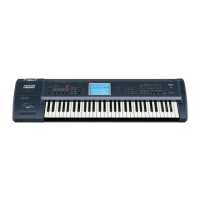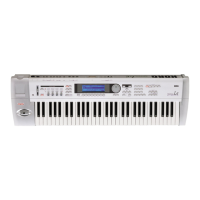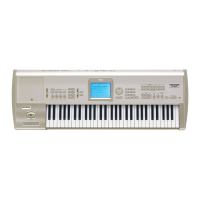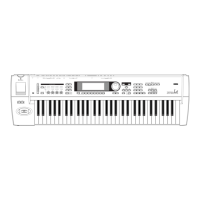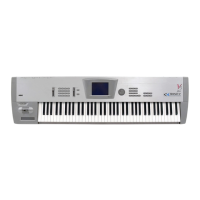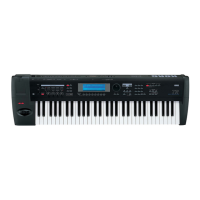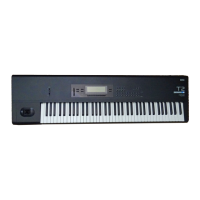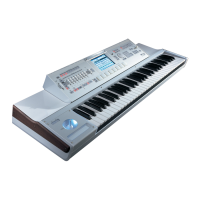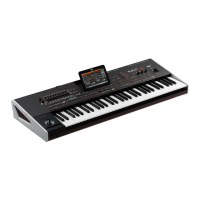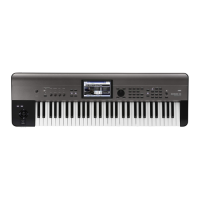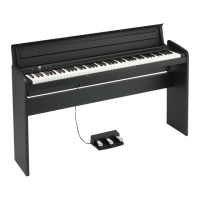
Do you have a question about the Korg TRITON Musical Instrument and is the answer not in the manual?
| Polyphony | 62 voices |
|---|---|
| Multitimbral | 16 parts |
| Oscillators | 2 per voice |
| Type | Workstation synthesizer |
| Sound Engine | HI (Hyper Integrated) Synthesis System |
| Synthesis Method | Sample-based synthesis |
| Number of Keys | 61 |
| Keyboard | Velocity-sensitive with aftertouch |
| Sound ROM | 32 MB (expandable with EXB series) |
| Sequencer | 16-track sequencer |
| Arpeggiator | Yes |
| Display | 240 x 64 dot LCD |
| Connectivity | MIDI In/Out/Thru |
| Outputs | L/MONO, R, Headphones |
| Inputs | 1, 2 |
| Power Supply | AC adapter |
| Floppy Disk Drive | 3.5 inch 2DD/2HD |
Overview of the TRITON's synthesis system and sound capabilities.
Details on the TRITON's versatile effects section, including insert and master effects.
Information on the TRITON's sampling features, RAM, and ease of use.
Explanation of the TRITON's dual polyphonic arpeggiator system and its capabilities.
Description of the TRITON's touch-sensitive graphic display for intuitive operation.
Details the EXB-MOSS option board for advanced synthesis sounds.
Explains EXB-PCM boards for expanding PCM memory and adding new sounds.
Describes the EXB-SCSI interface for fast loading and saving of samples.
Information on SIMM modules for expanding sample RAM capacity.
Guide on connecting the TRITON to audio systems and power.
Introduction to Disk Mode and loading preload disks.
Detailed explanation of the TRITON's front panel controls and layout.
How to navigate and select sounds (Programs) from the TRITON's memory.
Method for organizing and selecting Programs by instrument category.
Explains how controllers affect sound and modulation.
Demonstrates the Sort function for arpeggiator patterns.
Explains the Key Sync function for synchronizing arpeggio patterns.
Demonstrates the Keyboard function in arpeggiator mode.
Guide on how to choose and select Combinations from memory.
Method for organizing and selecting Combinations by instrument category.
Allows selection of timbres and setting of pan/volume levels.
Covers MIDI channel, status, and OSC/Pitch settings for timbres.
Enables setting data filters for MIDI controller information.
Provides settings for arpeggiator assignments and zones.
Relates to insert and master effects parameters.
Step-by-step guide to exploring effects in Program mode.
Adjusting master EQ gain levels and saving changes.
How to manage insert effects for timbres in a Combination.
Guide for connecting a microphone and setting input levels.
Instructions for using the TRITON's Vocoder effect.
Defines basic terms used in Korg's sampling functions.
Configuration settings for audio input in sampling mode.
Settings for sample recording, including mode and key assignments.
Steps to name multi-samples for better organization and recall.
Process for converting recorded multi-samples into playable Programs.
Techniques for sampling rhythmic phrases, loops, and managing tempo.
An overview of the sequencer's extensive features.
Instructions for loading pre-made template songs to start composing.
Information on setting locate points for rehearsal and recording.
Initial steps for creating a Cue List.
Process for creating new songs and copying existing song data.
Loading a demo song to demonstrate RPPR functionality.
How to trigger patterns using the keyboard with RPPR.
Playing back a demo song to showcase RPPR.
Loading a template song to create a new RPPR-based song.
Assigning patterns to keys and configuring RPPR settings.
Steps for setting up and recording RPPR patterns into the sequencer.
Tutorial on copying Combinations with arpeggiators into the sequencer.
Exploring advanced arpeggiator editing functions within Program mode.
Demonstrates the Gate function for controlling note length in patterns.
Explains the Velocity function for adjusting note loudness in patterns.
Guide to creating and editing custom arpeggio patterns in Global mode.
Setting the tone mode for arpeggio patterns.
Introduction to recording Combinations with arpeggiation.
Key points regarding Combinations and their structure.
Key points regarding arpeggiators within Combinations.
Tutorial on using a multi-channel Combination in the sequencer.
Tutorial on using a single-channel Combination in the sequencer.
Steps to demonstrate routing song tracks to individual outputs.
How to easily route individual drum sounds or samples.
Details the EXB-MOSS tone generator and its features.
Describes the EXB-SCSI interface board for fast data transfer.
Information on EXB-PCM boards adding multisamples and drum samples.
Details on SIMM modules for expanding sample RAM capacity.
References for procedures related to saving and loading data.
References for information on Song Play Mode.
References for information on Global Mode settings.
References for using MIDI, Host Port, and computer connectivity.
